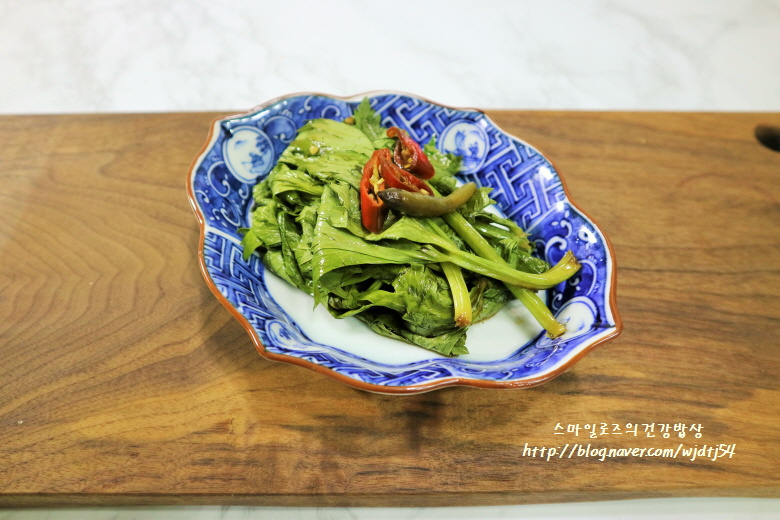Fragrant Celery Leaf Jangajji: An Economical Way to Enjoy It
From Celery Prep to Preservation: A Delicious Jangajji Recipe Using Celery Leaves

Introducing celery leaf jangajji, perfect for cleansing your palate after rich or greasy meals. Many people discard the celery leaves, using only the stalks. Today, we’ll explore everything about celery, from proper preparation and storage to making a delicious jangajji with the often-overlooked leaves! This recipe is wonderfully simple as it requires no boiling, making it easy to prepare at room temperature.
Ingredients- 1 head fresh celery leaves (along with stalks)
- 2 cups soy sauce
- 1 cup vinegar
- 1 cup soju (optional, for preservation)
- 1 red chili pepper (for garnish and flavor)
- 1 cup sugar (optional, for sweetness adjustment; omitted here)
Cooking Instructions
Step 1
First, thoroughly wash the celery under running water to remove any dirt or debris, then drain it well. Since it might be difficult to submerge in a large container immediately, let the washed celery sit in a colander to drip dry.

Step 2
Separate the celery stalks from the leaves. Carefully detach the thin, tender leaves from the ends and set them aside. Soak both the separated stalks and leaves in water with 2-3 tablespoons of vinegar for about 10 minutes. This process helps remove any unwanted odors and makes the celery fresher. Afterwards, rinse them under cold running water and drain completely.

Step 3
Peeling the celery stalks makes them even more tender. To easily peel them, hold the stalk about 15 cm from the end and snap it; the peel should come off smoothly. While you can eat the peel, removing it from thicker stalks significantly improves the texture, making them more pleasant to eat.

Step 4
Trim off about 1 cm from the ends of the celery stalks that are dirty or tough. Then, cut the stalks into bite-sized pieces. Today, we’re cutting the stalks into two lengths, approximately 15 cm and 7 cm, to enjoy varied textures.

Step 5
Also prepare the celery stalks cut to a slightly smaller size of about 7 cm. Cutting them into similar lengths will make the finished jangajji look appealing and easier to handle when serving. Store the prepared celery stalks in an airtight container or wrap them in plastic wrap.

Step 6
Now, let’s make the celery leaf jangajji without boiling. Ensure the separated celery leaves are completely dry, then pack them neatly into your chosen container. The leaves will compress once the liquid is added, so don’t worry if they seem to fill the container initially.

Step 7
Prepare enough soy sauce mixture to completely submerge the celery leaves. If you prefer a spicier flavor, you can add thinly sliced hot green peppers at this stage. (The red chili is for garnish.)

Step 8
Pour the prepared soy sauce mixture over the celery leaves. Arrange the thinly sliced red chili pepper on top for visual appeal. Adding an equal amount of soju as vinegar helps to mellow the saltiness of the soy sauce and preserves the jangajji, allowing it to be stored at room temperature without spoiling. While the celery stalks can be used in stir-fries or salads, transforming the easily discarded leaves into this flavorful jangajji creates a fantastic side dish that pairs wonderfully with rice. This celery leaf jangajji is truly a delicacy!

Step 9
You can start enjoying the jangajji about 3 to 4 days after making it. Unlike the stalks, the leaves absorb the seasoning much faster, resulting in a delicious pickle in a short amount of time.

Step 10
After 5 days, opening the container reveals that the flavors have perfectly permeated the leaves, making them look appetizing.

Step 11
Serving a portion, wow! The fresh, tangy, and sweet aroma is incredibly enticing and appetizing.

Step 12
Place a spoonful of this celery leaf jangajji over warm rice and enjoy. It makes a wonderful side dish that elevates your meal. Even if you’re concerned about celery’s strong aroma, the jangajji preparation mellows it considerably, making it enjoyable for everyone.

Step 13
This way, we fully utilize the celery by enjoying the fresh stalks in salads daily and preserving the leaves as jangajji, ensuring nothing goes to waste. Celery leaves are known to help cool the body and soothe the skin. Furthermore, celery is very low in calories at about 12 kcal per 100g, and is often called a ‘negative-calorie food’ because the body expends more energy digesting it than it consumes. It’s highly beneficial for diets, so incorporate celery into your routine for good health!



